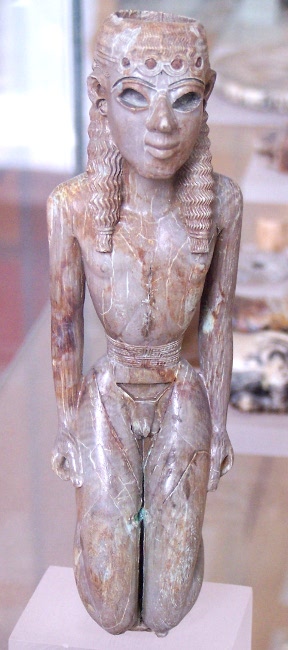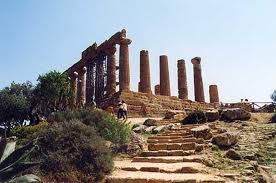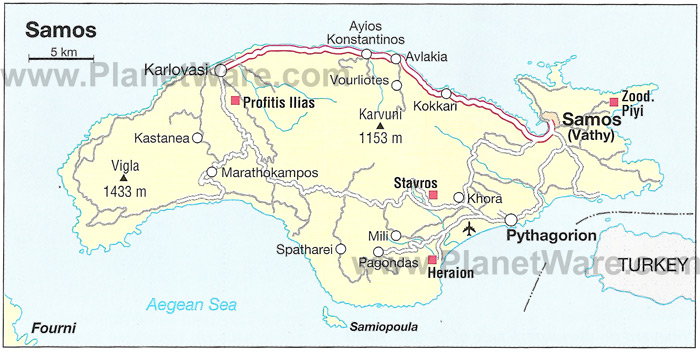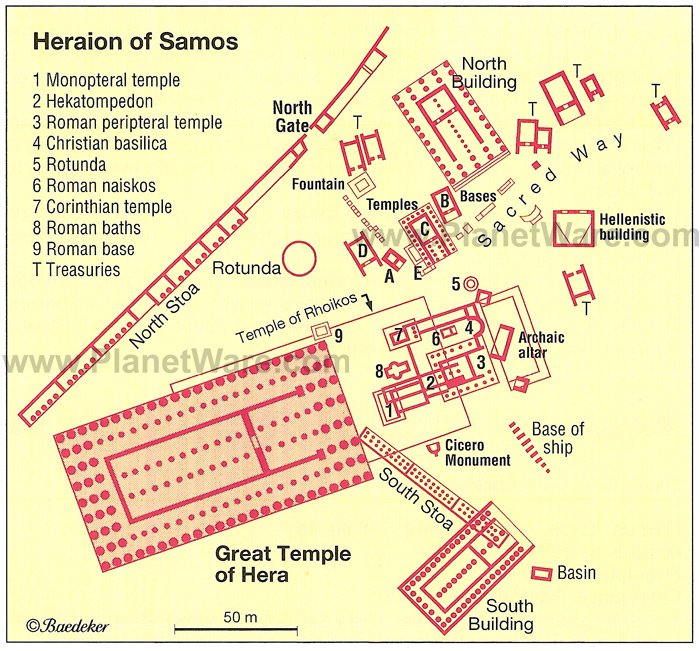Sanctuary of Hera, Samos
Archaeological Development
Due to the lack of literary sources related to the Sanctuary of Hera in Samos, we are forced to almost exclusively rely on the results from archaeological excavations. Pausanias ommitted a detailed account of the site from his famous descrption of Greece and Herodotus mentions the Heraion with other scattered sources but these are referenced centuries after the peak of the Hera cult at Samos.
The first modern identification of the sanctuary was carried out by Joseph Piton de Tournefort, a french doctor and natural scientist who was comissioned to travel in Greece in 1704 and he realised half a temple column had been left standing upright. In the 18th and 19th centuries more travellers investigated the visible remains although flooding stopped some areas from being examined. Later excavations in the late 19th century discovered the temples at the sanctuary proved to be Late Archaic buildings of colossal dimensions. (55.2 x 108.6m) [1]
The first temple (the Hekatompedos) was west of the altar and dates back to 8th century BC, the time of the cult civilisation at Samos and was one of the earliest of all Greek temples. [2] It was constructed at 100ft long before being replaced by a pseudo dipteral temple (a temple where the inner range of columns surrounding the cella are omitted) built before the middle of 6th century BC. [3] The replacement of this temple led to the architects Rhoikos and Theodorus rebuilding the site to its magnificant scale starting the design of one of the earliest series of Iconic temples. [4] The altar was newly rebuilt on a much larger scale with a new east-west, axial orientation to the temple as opposed to the former south eastern orientation. A gated entrance to fortify the sacred precinct was built propping up the 'North Wall', which was a double aisled cella with a ring of columns as a later addiction. The 'South Wall' was later begun contributing to the beginning of many new smaller temples paving the Sacred Way- the most prominent topographical feature of the sanctuary of Hera. (e.g smaller temples arose by the North of the Sacred Way). The Archaic Heraion was in very close proximity to 10 other temples none of which had their own altar. This can allow us to assume the Great Altar of Hera served a magnitude of temples. [5]
A decade or so later, the new 'Rhoikos' temple replacement was destroyed after completion most likely by an earthquake, to cause such irreplaceable damage to Ionian architecture as the limestone surrounding the wooden entablature was untouched.
Gods/Heroes
The Sanctuary of Hera was dedicated to Hera, Queen of the Gods and wife of Zeus. Hera's cult sanctuary is split between Argos, Mycenae and Samos. [6] It is believed as the core legend of Samos that the goddess was born under a sacred Lygos tree leading to the foundation of the Heraion and the supposed original naming of the island of Samos as 'Parthenie', 'The Virgin'. The island of Samos also holds great significance to Hera as the River Imbrasos next to the site is where Hera and Zeus celebrated their wedding.
The earliest characterizations of Hera when she first emerged in Greek cult was that of Parthenos influencing Pindar's Olympian Ode where he refers to her as 'Hera the Virgin'. [7]It is claimed that Zeus and Hera first slept together in absolute secrecy for 300 years, contributing to the culmination of 'great love' between the two which differs greatly from her loss of status in Homer. Homer describes Hera as more of a jealous and conspiring wife than an effectionate and willingly submitting one. Hera is also recognised in Homer's work by the epithet 'Cow-eyed mistress' associated with her connection with animals and birds. [8] [9]
Ritual Activity
Sacrifice
There is evidence of sacrifice taking place at the Sanctuary of Heraion from the debris of animal bones and the pottery, drinking cups, amphoras and goblets used for sacrificial meals. The animal bones are suggestive of the feasts consumed amongst participants after sacrifical ceremonies. The bones from bovines, sheeps and pigs were the most commonly sacrificed animals and goat was the least according to the bones that were left to be examined. The clay oxen found in the sanctuary excavations show us that oxen were sacrificed on the altar during cult activities and festivals, relating to the 'ox emblem' on Samian coins indicating the goddess Hera as a protectress once more.
Interestingly, when excavating the sanctuary, both Egyptian crocodile and African antelope fragments and skulls were unexpectedly found. [10] This is indicative of the trade connections Samos acquired in the early Archaic period, as it is likely that these animals were bought by Egyptian travellers as trophies and then dedicated to Hera.
The excavation finding evidence of sacrifice in the Heraion verifies the exact sacrifical procedure Homer describes, down to the special treatment of thighs being wrapped in fat and burnt on the altar.
'When the dark blood had gushed out and life had left the heifers body, they swiftly dismembered the carcass, cut out the thigh bones in the usual way, wrapped them in folds of fat and laid raw meat above them... When the thighs were burnt up and they had tasted the inner parts, they carved the rest into small pieces, pierced them with skewers and held the sharp ends to the fire till all was roasted.' [11]
Dedications
There is much evidence of votive offerings and dedications to Hera which reveal what types of people visited the sanctuary and dedicated gifts. For instance when items like pine cones were discovered, it was assumed that these were truly personal votive offerings cosnsidering the cones would not have grown in the area, they were gifts from afar differing from the more typical materialistic gifts of marble or precious metals.
Furthermore excavations reveals pieces that proved both common people and the aristocratic classes worshipped the goddess. The votive offerings of 'the common people' had much lower commerical value such as plain wooden bowls or inartistic items made from limestone. On the other hand objects uncovered at Samos such as the many horse trappings, harnesses and bridles point to Hera as protectress of horses and indicate more wealthy and privileged aristocrats visited the sanctuary. Also indicative of this is the many imports found at Heraion such as a splendid Egyptian ivory carving or the lion brought to Samos from the Ramessid era from Pharoahs in Egypt. Hera was recognised as the goddess 'Gula' by visitors from the East which portrays the cultural element of her significance and her international status.

The most notable of the objects dedicated to Hera in the Archaic period were little model boats of about 40cm which replicated Greek trading vessels or warships. These were personal objects made especially for the Heraion at Samos. However, it is debatable whether these were objects personal to those who contributed to the cult of Hera instead of typical votives as one would expect to see greater variety in the intricate details of the boats. The frequency of the model boats appearing at the sanctuary was also symbolic of the importance of seafaring to Samos in general- as representations of the ships later appeared on coins circulating around Samos.
Festivals and Cult
The local myth relayed by Menodotus of Samos contains references to cult ceremonies and practices. It is believed that Admete, daughter of Eurystheus fled from Argos to Samos. To punish her for fleeing, the Argives instructed Etruscan pirates to carry the wooden Samian cult image away. However the pirate ship with the stolen cult image was unable to set off and the pirates escaped in confusion. When the Samian islanders discovered their image outside the temple they assumed it had escaped alone and bound it with rods from the Lygos tree. Thus the annual festival of Hera was called the Tonaia (binding) where the main ceremony involved participants dragging the image out of the temple and to the seashore where they would then make a great show out of searching for the statue and uncovering it for it to be purified. Varro states the statue was draped with bridal robes as 'The annual rites of Hera are celebrated in the form of a marriage' thus the festival sought to immitate marriage rites between Hera and Zeus [12] The goddess' birthplace is also involved in the festival where cult members wound lygos branches around themselves from the sacred tree Hera is believed to have been born under.
The remnants of fruit such as grape seeds and olive pits show us evidence of the types of fruit consumed during the festival of Hera. It was believed fruits rich in seed reflected Hera's divinity as a great fertility goddess.
Other
Interesting to see the marked initials 'HRH' on some of the pottery and goblets/amphoras/drinking cups found in excavations. This evidences the clear connection between the goddess Hera and the sanctuary dedicated to her, and none of the labelled items appeared anywhere outside Heraion.
Historical Significance
The rebuilding of the Hera temple in the 6th century by Rhoikos and Theodorus was heavily influenced by the start of the political 'Tyrannis' : 'The dominion of the individual supported by economic and military superiority'. The beginning of this period begun in 600BC by the first tyrant Demoteles. Another notable figure was Polycrates who seized power in 538BC to 522BC. The competitiveness and obsession with power is believed to have manifested itself visually in the magnificent marble kouroi that paved the Sacred Way, each marble rivalling eachother in size.
After the Rhoikos sanctuary was destroyed by an earthquake the remodelling took place under the reign of Polycrates but was left incomplete after his death. This is when the political and economic power of Samos began to majorly decline leading to Samos being temporarily owned by Ionia before the Persians spared Samos after the uprising of the Ionian Revolt. Finally the eventual siege and capture of Samos by an Athenian contingent under Pericles in 441 B.C reslted in the complete and final absence of power after Samos has paid heavy taxation and lost all of its fleet.
It is interesting to see how the collapse of Samos in the 5th and 4th centuries BC is reflective upon the sanctuary architecture. For instance the dedications and offerings discovered are of a much grander scale in the Archaic period when the Hera temple was first built and the cult was at its floruit, than in the earlier centuries. For instance the bronze group of Myron in the 5th century makes a poor impression in comparison
Who used the site, and where did they come from?
The cult of the Heraion
The first traces of continuous cult presence dates back to the 2nd millennium BC where cult bowls were found which had already been used suggestive of cult worship already having taken place. As there are no first hand handwritten testimonies concerning the Samian Hera cult we have little clear evidence of the goddess and cultic rituals.
The local Samian historian Aethlios (500BC) recorded 'The image of Samian Hera was originally a plank of wood, later taking on a human figure'. [13] This is attested by the poet Callimachus in the 3rd century BC who was familar with the 'uncut plank' image before Greek immigrants carved the goddess into her human form.
Select Site Bibliography
H. Kyrieleis (2004) 'The Heraion at Samos' from Greek Sanctuaries: New approaches Robin Hagg and Nanno Marinatos.
T. Fyfe (1965) Hellenistic Architecture: An Introductory Study
M. Rigoglioso (2009) The Cult of Divine Birth in Ancient Greece
R. Hard (2003) New Handbook of Greek Mythology: Based on H.J. Rose's Handbook of Greek Mythology
W. Burkert (2013) Greek Religion- Archaic and Classical
J.V. O Brien (1993) The Transformation of Hera: A Study of Ritual, Hero, and the Goddess in the Iliad
M Emerson (2007) Greek Sanctuaries- An Introduction
S. Blundell, M. Williamson (1998) The Sacred and the Feminine in Ancient Greece
Footnotes
[1] Kyrieleis (2004) 100.
[2] Kyrieleis (2004) 100.
[3] Fyfe (1965) 29.
[4] Emerson (2007) 18.
[5] Kyrieleis (2004) 104.
[6] Burkert (2013) 2.
[7] Pindar Olympian Ode 6.88.
[8] Homer Illiad Book 1- 551 and 568.
[9] Rigoglioso (2009) 118.
[10] Kyrieleis (2004) 109.
[11] Homer Odyssey Book 3
[12] Hard (2003) 136.
[13] Kyrieleis (2004) 118.
Location
The Sanctuary of Hera in Samos lies in the Southern region of the island, about 6km southwest of the city (Pythagoreion today), near the coast and the river Imbrasos. The reason for the distance of the sanctuary and the inner city can only be explained by the significance and permanence of the buildings and cultic activity- the temples had established their sense of ownership thus the Heraion unmistakeably belonged to Samos. Another recognisable feature of the sanctuary was its near straight path from the Heraion to the Sacred Way, where many of the smaller buildings lay amongst the path.


Site Plan

